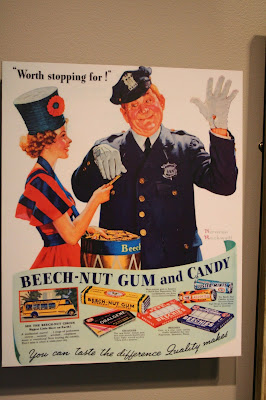The sultry south winds and thunderstorms of the previous evening were replaced with crystal clear skies of blue and refreshing breezes from the west. A fast moving cold front brought an abrupt end to yesterday's oppressive heat. We arose and, without feeling an immediate urgency for breakfasting, motored across the river to the Schoharie Aqueduct Park.
 |
| A "Canadian Crocodile" spotted off the bow! In the U.S., this type of crocodile is known as "driftwood" |
|
Schoharie Aqueduct was built as a way for early canal boat passages in
the 1830's to avoid the crossing of the tempestuous Schoharie Creek.
The creek, by nature, would often rise quickly and flood into the Mohawk
River, creating some perilous navigation issues in the swirling
waters. These early builders created a series of locks on either side
of the creek and raised the canal boats up through the locks, across the
creek on a bridge and then back down again to river level. The feat,
done without any of the mechanical advantages we have today at our
disposal, was an amazing one. The stonework for the aqueduct was
equally amazing to see as well.
 |
|

Underway again up the Mohawk River we motored on through and past lock
13. The river wound its way through cuts and passes in the mountains
and led us into the town docks at Canajoharie. The town itself was
settled by Dutch and German immigrants and that heritage is noted by the
street sign names and by the horse and carriage consists that the
Amish, who still live in this area, utilize for transportation.
 |
| Mountains meet he Mohawk River |
 |
| Approaching Lock 12 on our way to Canojoharie |
 |
| Gaty's grandmother taught French in Canajoharie. It may have been at this school |
 |
| What the Heck? Totally non-PC |
The town is also notable for the presence and history of the Beechnut
Factory. Bartlett Artel, who co-founded the company, made a
tremendous fortune in canning and packaging foods. Bacon, baby foods,
canned spaghetti.... you name it. The list of canned and packaged goods
produced at this factory was outstanding. Artel was good to his
employees and sought to bring his own love and appreciation of art to
his workers. He was known to pipe in classical music to the work floor
and even offered art classes for his employees who wished to exercise
their creativity. He founded a library and an art museum in the town
and collected art for others to see and appreciate. The factory is
empty now and slated to be torn down but the legacy remains and his
contribution to the town and to the arts survives today in this small
upstate New York town.
We moved on from the museum to visit the place for which the town derived its name.
Canojoharie is said to be a Mohawk language term meaning "the pot that washes itself," referring to the "Canajoharie Boiling Pot," a circular gorge in the Canajoharie Creek, just south of the village.
We visited this gem of a park and soon found ourselves napping in the shade of a tree and listening to the water burbling over the rocks.
 |
| Horses park in the rear at the onvenience store |
 Back on board later that evening, Gary cooked up a piece of Haddock that we procured from the local meat and fish butcher and dined on the boat, tied up on the Mohawk river at the city park as the sun set.
Back on board later that evening, Gary cooked up a piece of Haddock that we procured from the local meat and fish butcher and dined on the boat, tied up on the Mohawk river at the city park as the sun set.





















No comments:
Post a Comment